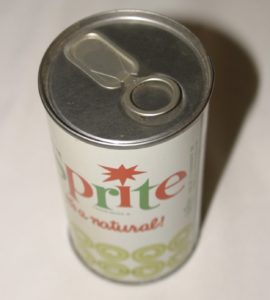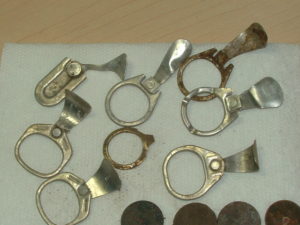
The year was 1959. A machinist/inventor/tinkerer named Ernie Fraze couldn’t sleep. A few weeks previously, he had gone on a picnic and realized that nobody brought a can opener to open the sodas, a common situation of the time. So, to tire himself out, he thought he would ponder for a while on how a self-opening drink can could be devised.
Ernie envisioned a pull tab anchored securely to a strengthened rivet at the center of the can, which, when lifted, would perforate the can’s top and allow a tab to be removed along scored lines.
With that bout of insomnia, the canned drink industry was revolutionized overnight.
Beer and soda pop drinkers were heavily dependent on can openers before then. For a time, cans were produced with a conical neck that ended in an opening to be sealed with a bottle cap, but they were expensive to produce, and consumers preferred cheapness over convenience.
Much loved by the American public, the rings later came to be most reviled. The reasons are manifold.
One was images of fish who had unfortunately gotten pull tab rings stuck around their bodies as youngsters and who had become deformed adults, with that ring horribly constricting their body girth. I’m not sure how many fish this ACTUALLY happened to, but the image was very distasteful to the public, and gave pull tabs a bad name with the environmentally-conscious.

Another downside to the removable pull tabs was nicely summed up by one Jimmy Buffett:
I blew out my flip-flop
Stepped on a pop-top
Cut my heel had to cruise on back home
And while booze in the blender assuaged his pain, the fact is that it was darned annoying to cut one’s foot on a discarded pull-tab.
The third factor in their being banned involved a bizarre action taken by some in the hopes of keeping the tab from getting loose from the can: the habit of dropping the removed ring INSIDE your can, before the contents were consumed.
That was begging for trouble. But, as is the Great American Tradition, many who ended up with a pull-tab in the throat called a lawyer first, the hospital next. Soft drink makers and soda can manufacturers were sued for what amounted to irresponsible behavior on the part of the litigants, but still lost many cases.
The combination of these factors spelled the end of pop tabs in the US and many other places by the mid 1970’s. Alternatives needed to be found ASAP, before we were back to carrying can openers! One silly method was on Coors beer cans of the era, among other brands. It consisted of two holes in the top, one larger than the bother, which were intended to be pushed in with a finger or thumb! And they thought pull tabs were dangerous?
In 1975, Daniel F. Cudzik of Reynolds Metals invented the pop-top as we know it. Nothing was discarded as the mechanism would easily open a can of pop and stay put on the can.
So today, we are safe from deformed fish, cut up heels, and swallowing tabs we’ve put in the cans ourselves. Why don’t I feel safe?
Do you have a picture of a fish stuck in a pull tab?